Peace lilies are by far one of the most popular houseplants to grow because they are low maintenance and fairly easy to care for.
They can be a bit fussy though, so it’s very important to understand what they need to thrive. Once you get the hang of it, you’ll be able to enjoy them for many years to come.
In this complete care guide, I’ll show all you need to know about how to grow peace lily plants. Including details about water, soil, light, fertilizer, pruning, flowering, propagation, pest control, and much more.
Quick Peace Lily Care Overview
| Scientific name: | Spathiphyllum |
| Classification: | Tropical plant |
| Common names: | Peace Lily |
| Hardiness: | Zones 11+ |
| Temperature: | 65-80°F |
| Flowers: | White, can bloom year round |
| Light: | Full to partial shade, bright light indoors |
| Water: | Keep soil evenly moist, do not overwater |
| Humidity: | Average to high |
| Fertilizer: | General purpose plant food spring-summer |
| Soil: | Fast-draining, fertile soil |
| Common pests: | Spider mites, mealybugs |
Information About Peace Lilies
The peace lily (Spathiphyllum) is a very common indoor plant with lovely green leaves and stunning white flowers. It’s in the Araceae family, along with dieffenbachia plants and Chinese evergreens.
Though they are native to the tropical areas of North and South America and parts of Asia, they can easily adapt to growing indoors.
Commonly gifted as sympathy plants, they’ve gained a lot of attention in the past few years because they are air purifying houseplants.
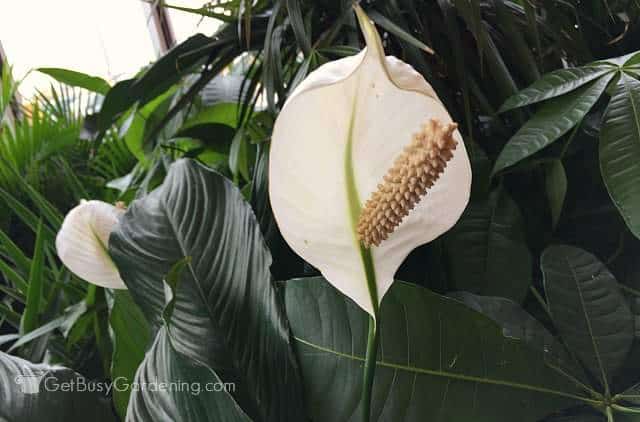
Different Varieties
There are several different types of Spathiphyllums, and they all require the same care. They look very similar to each other, but come in a range of sizes and foliage hues.
The sizes can be anywhere from the small varieties that only grow to be a few feet tall, to huge floor plants that are several feet tall. The leaf colors range from very dark to light green, or variegated.
Toxicity
All parts of the peace lily plant can be harmful if eaten. According to the ASPCA, they are toxic to cats and dogs.
If you have pets or small children around, then it’s best to keep this one out of reach. Otherwise, if you don’t want to risk it, check out my list of pet friendly houseplants.
Flowers
Most peace lily plants will bloom from spring through summer with the proper care. They are prized for their distinctive white flowers that stand above the foliage on tall stems. It’s the feature that most people recognize first.
They need lots of bright, indirect light to bloom. Once they’re done flowering, they usually have a rest period during the fall and winter months.
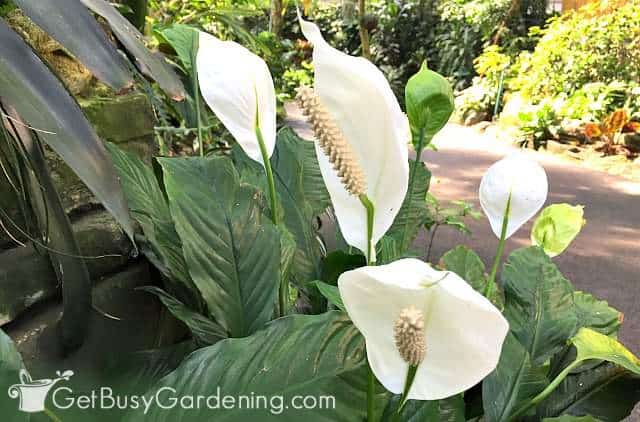
Peace Lily Care & Growing Instructions
Growing a peace lily isn’t difficult, but it’s important to give your plant the proper care so it will stay healthy and happy. Follow my detailed tips below for the best success.
Water
Proper watering is one of the most important parts of peace lily care, and giving them too much is their #1 cause of death.
They prefer to dry out slightly between waterings, and won’t tolerate wet feet for long. Push your finger 1-2 inches deep into the soil. If it feels damp, then don’t add anymore water. Use a moisture gauge to make it easy.
When it’s time, give your plant a deep drink, and allow the excess to drain completely out of the bottom of the pot – never leave it soaking.
It’s important to note that peace lilies are sensitive to the salts and chemicals in tap water. These additives can cause yellow or brown leaves, tips, and margins. So use distilled, filtered, or rainwater on them if you can.
Humidity
Since they come from tropical areas, peace lilies like a lot of humidity. They can adapt fairly well to lower levels, but extremely dry air will cause brown leaf tips and edges.
You can increase it by running a humidifier nearby or misting the leaves regularly to see if that fixes the problem.

Light
Peace lilies make great low light houseplants because they actually don’t like any direct sunlight. Too much sun will cause the leaves to fade, turn yellow, and/or burn.
However, they won’t grow well or bloom if it’s too dark. They need bright light, and filtered or indirect are the best.
Somewhere near a bright window or in a sunny room would be the perfect spots. If your home is too dark, then you can add a grow light.
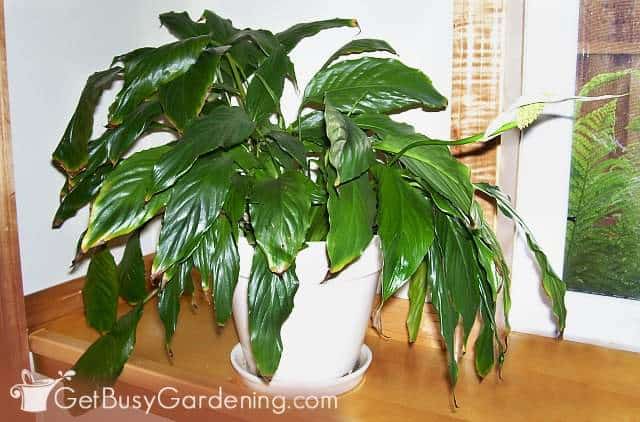
Soil
Peace lilies aren’t fussy about the type of soil you use, any high quality general purpose mix will work just fine. But they do prefer one that drains well.
If you tend to overwater, you can mix in some perlite, pumice, or coarse sand to increase drainage. They also like it slightly acidic, between 5.8 and 6.5 is a good range. You can use a probe tool to test it.
Repotting
Another thing that makes a peace lily so easy to care for is that they like to be pot-bound. In fact, they really hate being repotted.
So you should only repot yours if it’s absolutely necessary. When the time comes, it’s best to do it in the spring.
Also, make sure the new pot isn’t much bigger than the old one. They don’t like having too much space, so you should only go up one or two sizes. And always be sure to use a container that has drainage holes in the bottom.

Fertilizer
Peace lilies aren’t heavy feeders, but you should fertilize your plant a few times during the spring and summer months to encourage fresh new growth and flowers.
However, they are very sensitive to synthetic fertilizers. These harsh chemicals can cause major problems, like burning the roots, or making the leaf margins and tips turn yellow or brown.
I recommend using organic products instead. A few of my favorites are liquid compost tea, indoor plant food, or general purpose granules.
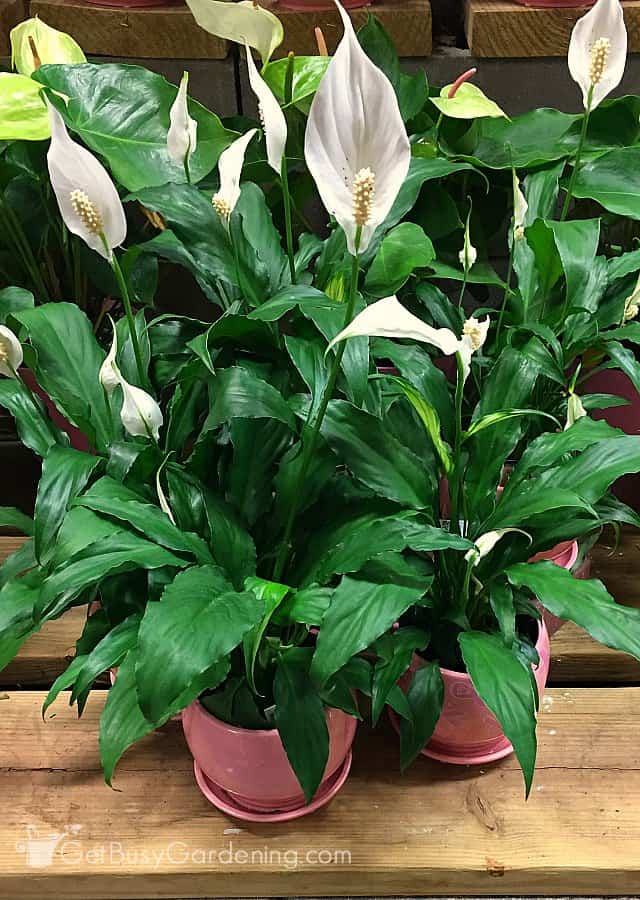
Tips For Controlling Pests
Healthy peace lily plants rarely have problems with bugs. But sometimes spider mites or mealy bugs can attack them.
If you find these pests, treat the leaves right away. Organic neem oil is a natural insecticide that is very effective at getting rid of them, and I highly recommend it.
Soapy water spray is also great for controlling pests. You can buy an organic insecticidal soap, or use a mixture of 1 teaspoon mild liquid soap per 1 liter of water.
Related Post: How To Get Rid Of Houseplant Bugs Naturally
Pruning
To keep your plant tidy and looking its best, you can prune it as part of your regular peace lily care routine. Here are some pointers:
- Remove brown leaf tips and edges by trimming them at an angle following the natural shape of the leaves.
- Cut dead or dying foliage all the way down to the base of the plant.
- Prune out faded or brown flowers and stems to help encourage more blooms.
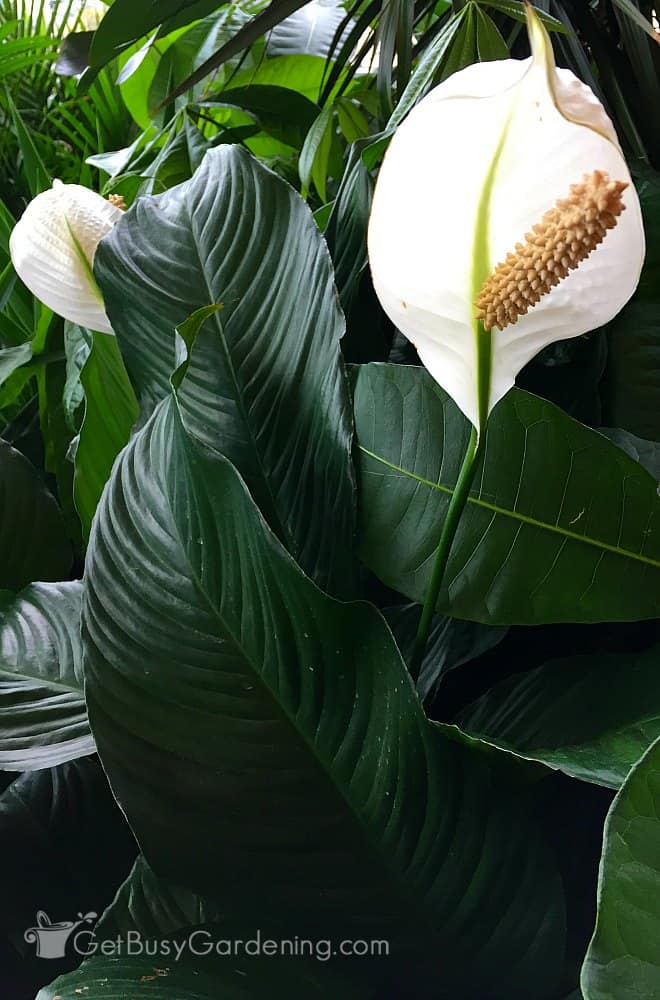
Peace Lily Propagation Tips
The only way to propagate a peace lily is to divide the rootball. To do this, remove it from the pot and gently untangle the roots – carefully working to separate the offshoots from the main plant.
If the rootball is really thick and dense, you may need to use a knife to cut it apart. Just be sure that each individual stem has roots, or it will not survive on its own.
Troubleshooting Common Problems
Peace lily care can be a bit daunting when your plant starts having problems and you don’t know why. Here’s a list of some of the most common issues, and tips for how to fix them:
Plant Is Drooping
Drooping is usually caused by over or under watering. But it can also be from sudden changes in temperature, or transplant shock after repotting.
If you recently moved it to a new pot, it should recover in a few days. Otherwise, check the soil and only water if it’s dry. Move the plant if it’s in direct sun, near a heat source, or exposed to a cold draft.
Leaves Turning Yellow
It’s normal for the older bottom leaves to turn yellow as they die, so you can simply prune those off. But if others are yellow, or there are several of them that turn at once, then it’s probably from overwatering or bugs.
Inspect the leaves for pests, and check to make sure the soil isn’t overly wet. It should dry 1-2″ deep between drinks.
No Flowers
The most common cause of a peace lily not blooming is inadequate lighting, they need bright light to flower.
Feeding your plant during the spring and summer, and regularly deadheading spent flowers will also help encourage blooming.
Brown Leaves Or Leaf Tips
This is almost always caused by improper watering, lack of humidity, or chemical damage from using tap water or synthetic fertilizers.
A yellow or white crust on top of the soil or around the inside pot edges are telltale signs of a salt or chemical buildup. Try using distilled, filtered, or rainwater instead, and switch to an organic fertilizer.

FAQs
Peace lilies can only live outside year-round in the warmest most tropical climates of zones 11+. They are extremely sensitive to cold weather, so if you choose to put yours outside during the summer, be sure to bring it back indoors before it drops below 65°F.
The most common cause of death for peace lilies is overwatering. The soil should dry 1-2″ deep, and never feel wet or saturated. Other common reasons are from chemical fertilizer burn, or prolonged exposure to hot or cold drafts.
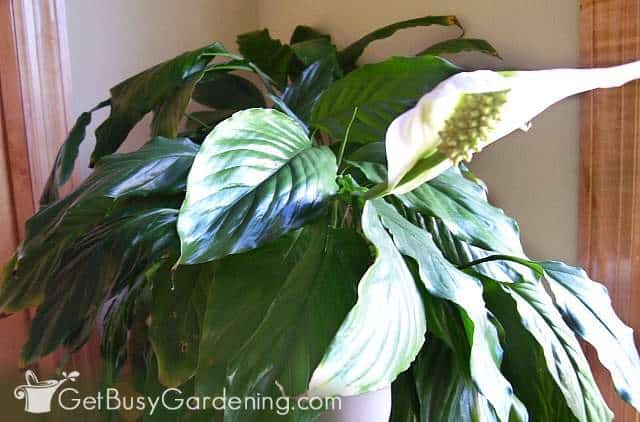
Now that you’ve learned exactly how to care for a peace lily, you’ll be able to enjoy your plant for many years to come. I know it can seem overwhelming, but you’ll get the hang of it in no time.
If you want to learn all there is to know about maintaining healthy indoor plants, then you need my Houseplant Care eBook. It will show you everything you need to know about how to keep every plant in your home thriving. Download your copy now!
More Plant Care Guides
Share your peace lily plant care tips in the comments section below.

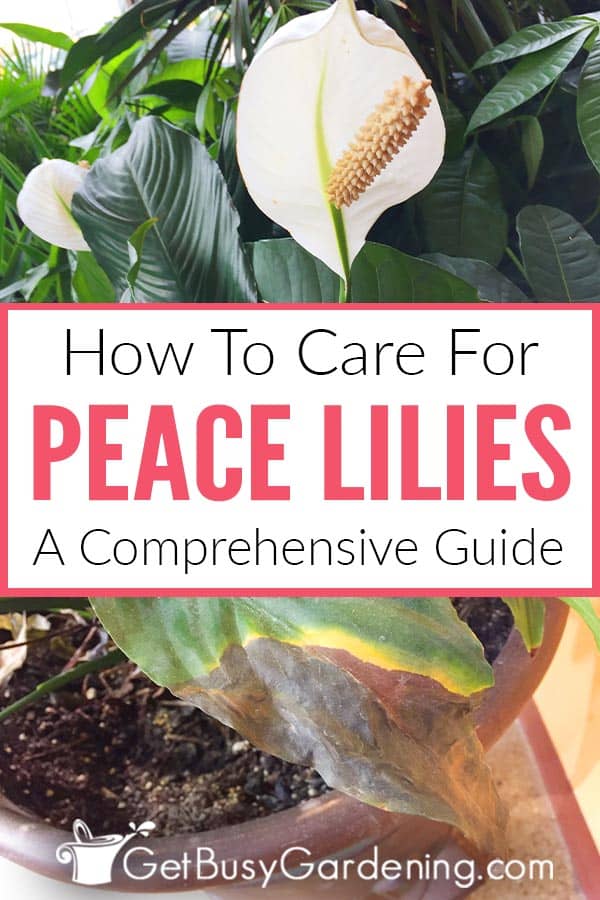
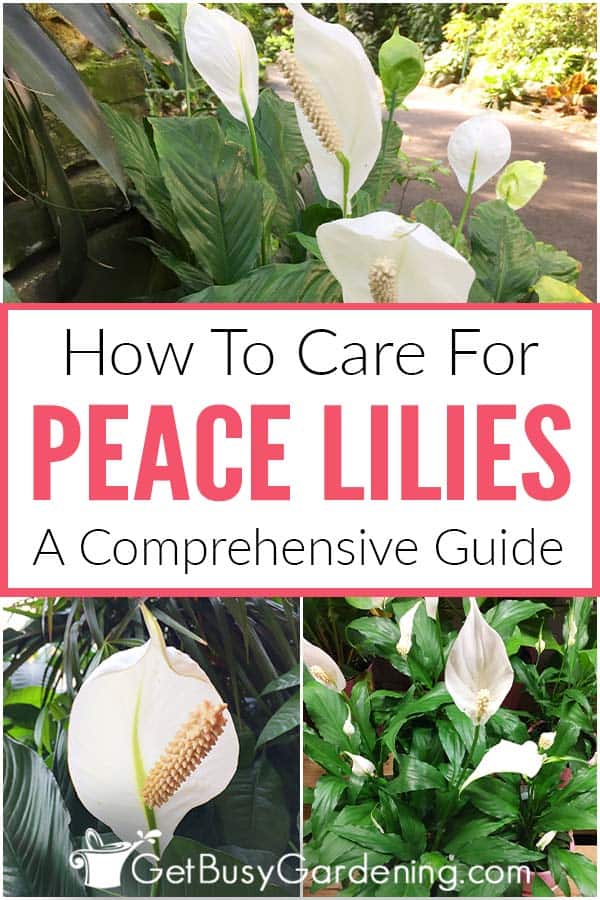



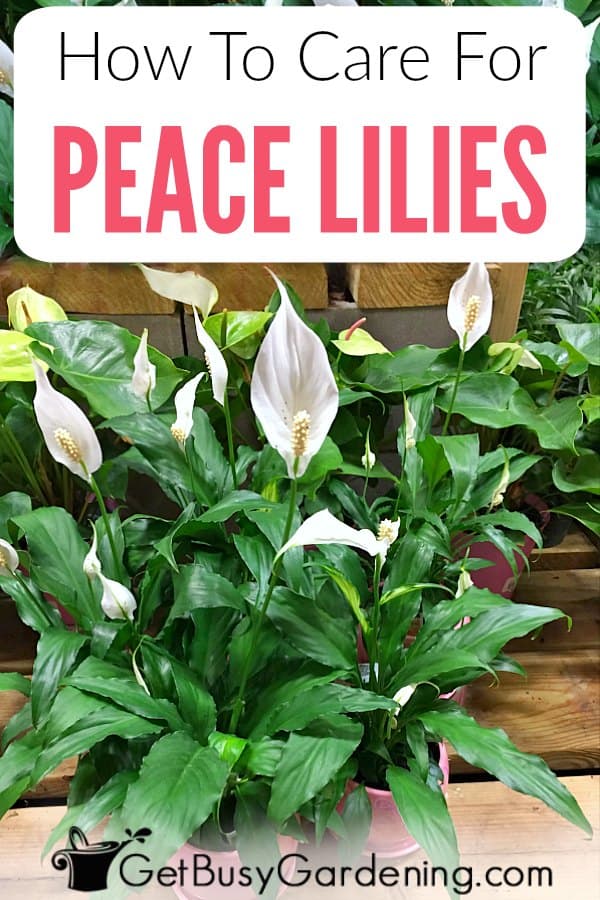




Rebecca Horton says
Hi Amy,
Several of my Peace Lily stems have brown/orange rough, scaly patches. The spots almost look like tree bark. Any ideas as to what might cause this? If so what should I do? Thanks. Becky
Amy Andrychowicz says
It sounds like your peace lily may be infested with scale, here’s how to make a positive ID and get rid of it.
Julie Crane says
Dear Amy
My daughter bought me this plant a few years back. It seems to be very healthy and lush green leaves and it does have a bought of flowering where I get lots of flowers, but they never grow very tall? They just seem to sit in around the leaves. The ones I have seen before seem to grow taller than the leaves? I’m not sure why this is, any ideas? It’s by a window but not in direct light, and I don’t over water it.
Julie
Amy Andrychowicz says
There are a few different types of peace lily plants – some are naturally larger than others. It sounds to me like yours is doing great, so I wouldn’t worry. It’s probably just a smaller variety. 🙂
Shirley Travis says
I have been given a peace lily plant & am now about to repot, I have just read your instructions about repotting, this is the first time I have ever had one of these plants, so please wish me luck that I maymhave some success. Thank you
Amy Andrychowicz says
Good luck repotting your peace lily, you’ve got this! 🙂
Plant Lover says
Hi Amy,
How much organic fertilizer should I give my Peace lily, we are supposed to be watering every two weeks, but I mixed peat moss and organic dirt, doesn’t need water every two weeks, when mixing organic fertilizer, it’s by the gallon, seems like too much watering.
Amy Andrychowicz says
Peace lilies don’t need to be fertilized very often, so just doing it each time you water would be fine. Yes, you definitely don’t want to water on a set schedule, like “every two weeks”. Instead, always check the soil to see how wet it is before adding more, or you could easily overwater.
Jenna Matthews says
My peace lily flowers are staying green and not turning white. What is causing this?
Amy Andrychowicz says
There are two main reason why your peace lily flowers are green instead of white. It could be caused by either too much fertilizer, or too much light (or a combo of both).
Ann says
Hi I’m Ann Otto, I’ve put my peace lily in my bathroom, during to my house being very dark. Will the steam in the bathroom be okay for my lily?
Amy Andrychowicz says
Yes, the humidity won’t hurt your peace lily, in fact it will love the extra moisture!
Mozella says
I have a baby peace lilies I can’t get it to grow what wrong with it
Amy Andrychowicz says
It’s hard to tell what could be wrong with your peace lily without more information. But, if it’s not growing, then it’s likely due to improper watering, lack of light or nutrients, or perhaps it’s overly pot-bound. I definitely recommend reading through this entire guide to see if you can figure out what the problem is.
Plant Lover says
Hello Amy,
My peace lily is thriving well, but I’ve noticed that the soil or whatever it’s potted in is quite low, what mixture of potting soil and other ingredients can I get to bring soil up to par.
Amy Andrychowicz says
You can just use a general purpose potting soil to fill the pot. But get one that is organic, or free from chemical/fertilizer additives as peace lilies are sensitive to them. See the section above titled “Best Potting Soil For Peace Lily” for more details and product links.
Doreen Wickberg says
Can I cut off a piece of the peace lily @put it in water to root, I have tried this & they root very easy but when I put them in soil it seems they are not growing.
Amy Andrychowicz says
Yes, as long as the stem cutting has a few root nodes on it, you can root a peace lily cutting in water.
Sandra says
I am struggling with my peace Lily.. at first there was one yellow leave near the bottom, I didn’t think much of it and trimmed it off but now a month later there is a black/brown spot on two of the leaves! I trimmed those off and applied neem oil.. I think I may have overwatered my plant. Is there any way I can safe it? I’ve tried putting cinnamon on top of the soil and not sure if i should try hydrogen peroxide method?
Amy Andrychowicz says
Sorry to hear that your peace lily is struggling. Yes, it does sound to me like you have overwatered it. The best thing you can do is to leave it alone, and let the soil dry out. I wouldn’t recommend trying any of the treatments you mentioned, unless you’ve found bugs on your plant. Those wont’ help at all with overwatering. Just check the soil a few times a week to monitor it, and don’t water again until it’s on the dry side. Read through the section above titled “Peace Lily Water Requirements” for tons of details about watering, including how often and the type of water to use. Also, if it’s not in a pot that has drainage holes, then I recommend repotting it in the spring into a pot with holes in the bottom to help avoid overwatering.